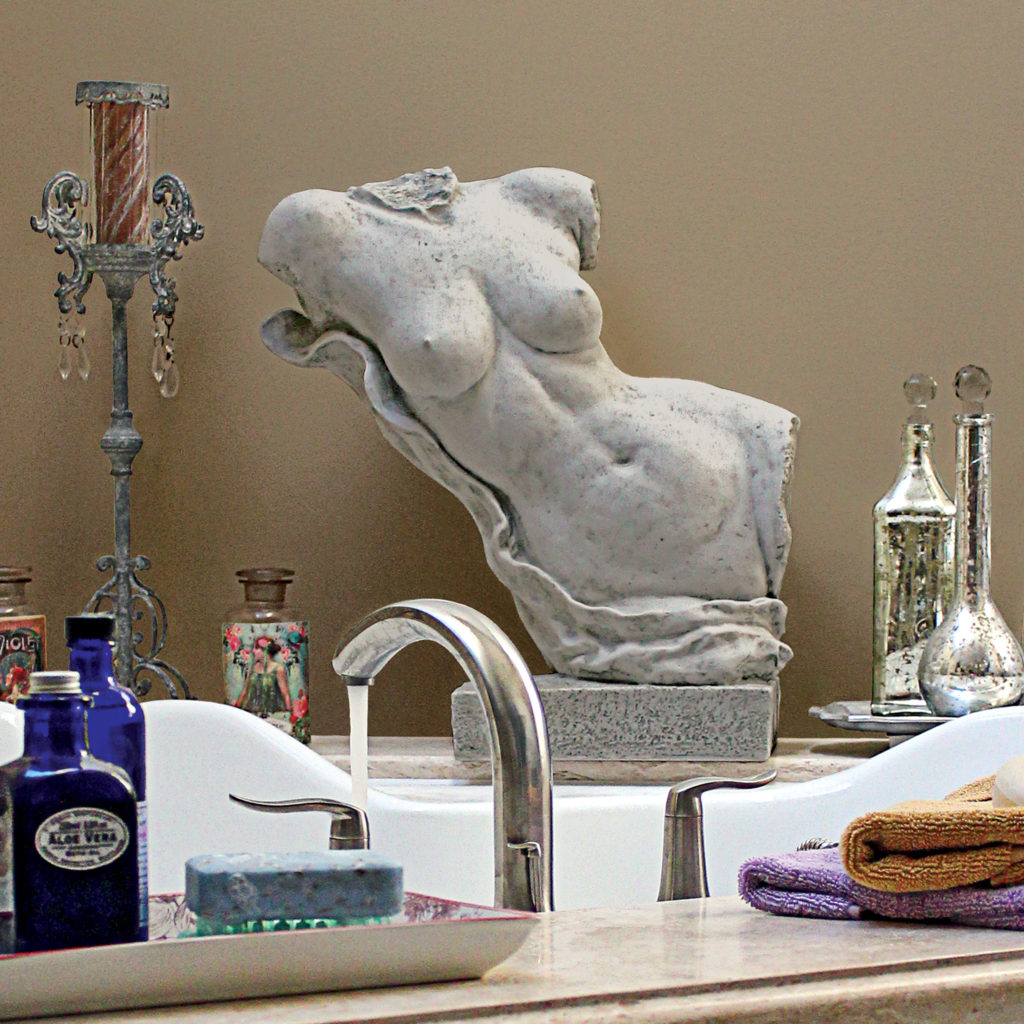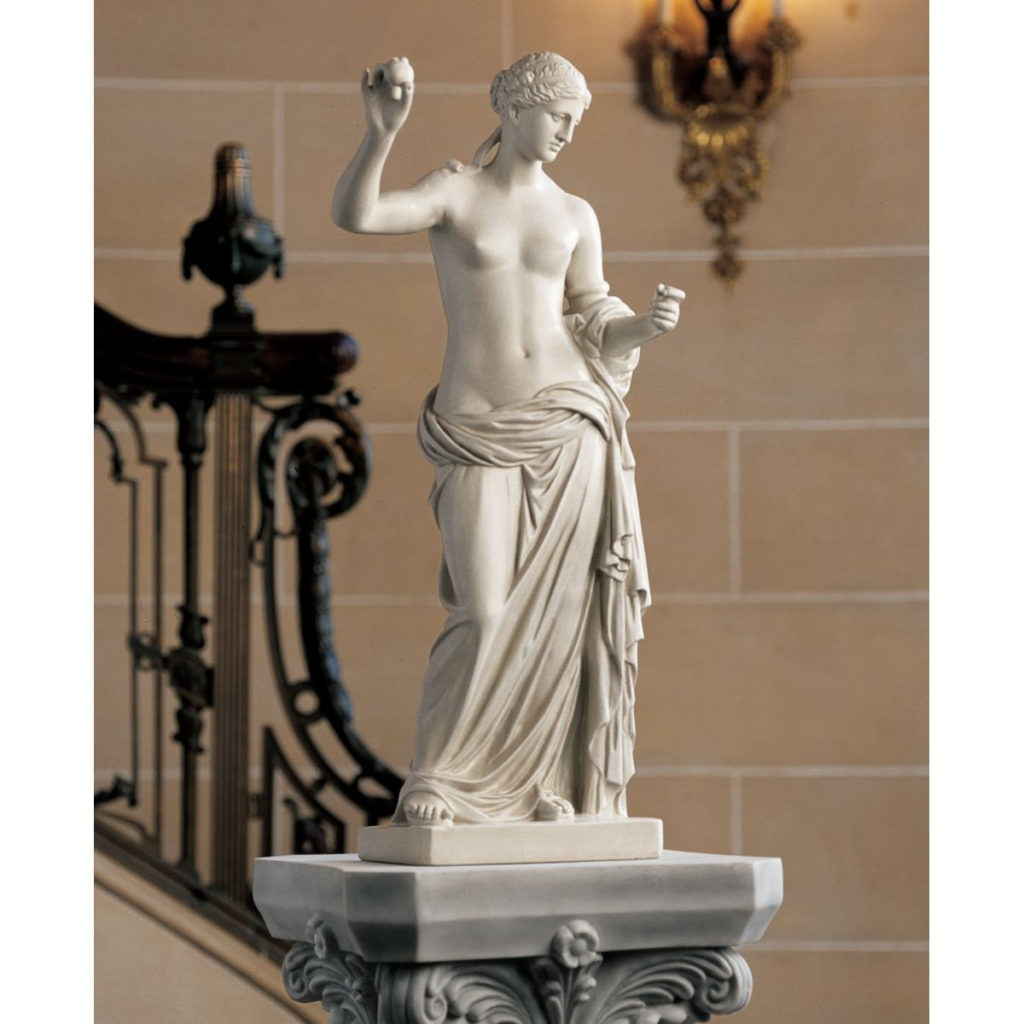“The Venus de Milo is an accidental masterpiece. Her lack of arms makes her strange and dreamlike.”
– Johnathan Jones, The Guardian, 2015
How did one of the most famous works of ancient Greek sculpture come to be known as the “Venus de Milo?”
The story goes like this: in 1820 a local farmer on the Island of Melos, in the Aegean Sea, was moving stones, at the same time an ensign from the French Navy decided to stretch his legs and go for a walk. This ensign saw the farmer uncover the top half of a marble statue of a lovely woman. The two kept looking, and among other broken bits of statues and a piece of a plinth, they unearthed the bottom half of the statue – legs covered in drapery.
The ensign told his commander and when they went to retrieve the statue they discovered it being carted away by the Turks. Following was an actual battle in the harbor over the statue as the French and Turkish sailors fought for possession of the splendid statue. It was said that each side ended up with one half of the statue and it has been speculated that her arms might have been broken or lost in that fight. Eventually, the French ended up with the rest of the statue, probably by buying it from the Turks.
The French ambassador presented the statue to King Louis XVIII who in turn donated it to the Louvre Museum in Paris where it remains today.
When it arrived there it was with the plinth fragment, and a left hand containing an apple that seemed to match the statue’s arm, material and technique; it even appeared that the weathering corresponded with that of the torso. Early on the plinth fragment was displayed along with the statue until it was lost. The fragment inscription read: “Alexandros son of Mendes, citizen of Antioch of Maeander” had created it.

The Director of the Louvre named the statue Victorious Aphrodite or Venus Victrix (Roman version) and it was repaired and given pride of place in 1821. However, the popular name of the statue that caught on was Venus de Milo as it was discovered on the isle of Melos/Milos.
As a masterpiece the Venus de Milo marble sculpture is held up as the ideal of feminine beauty. Design Toscano’s version, the Grande Venus de Milo Statue (KY1229) stands just shy of five feet tall, a stunning replica cast in designer resin with a faux stone finish. For extra height, we pair it with our Grand Laurel Plinth (KY3917) bringing the combined height to a dramatic seven feet. This image of Venus has met universal acclaim, being both impressive and elegant and our replica of this classic Hellenistic Age sculpture will add grandeur and style to your home both indoors or out.
FUN FACT: The style of lettering on the plinth fragment suggested the date it had been created was between 130-100 BC.
For a different look, our Aphrodite Goddess of Love Torso Fragment Statue (KY47077), the Greek name for the goddess of love and beauty, is replicated in this impressive twenty-inch high fragment with an antique stone finish perfect for a bath, boudoir, or outdoor garden wall.
FUN FACT: Because the Venus de Milo was similar to the artist’s known statues of Venus, she was first attributed to the Greek sculptor Praxiteles.
A fine example of Praxiteles’ works, the Venus of Arles Sculpture (NG32788) is also proudly exhibited in the Louvre. Unearthed in 1683, the Venus of Arles is posed with the golden Apple of Discord, awarded as the prize for the most beautiful goddess by Paris, in her right hand. At two-feet tall you can display this masterwork on a pedestal or tabletop.
FUN FACT: It is largely because of the apple placed in the broken left hand discovered with the statue, that she was called Aphrodite/Venus.
The exotic beauty of Venus Holding Apple Statue (NE90041) is displayed in our life-size sculpture of the goddess Aphrodite bathing, a classic sculpture perfectly placed in an entry hall, poolside or in the garden. At five-and-a-half feet tall with a faux stone finish this sculpture of Venus Holding Apple, will grace your home in with classic Greek style.
FUN FACT: The Venus de Milo’s white marble body was most likely originally painted in the style of polychromy.
Many of the masters of modern art have been inspired by the Venus de Milo such as Paul Cezanne and Salvador Dali’s “Venus de Milo with Drawers.”
The pride of place on any shelf or tabletop, this Venus de Milo Bust Statue (EU15816), will become an instant focal point. Classically beautiful and charming this bust modeled on the Venus de Milo and sculpted atop a faux ebony museum mount will turn any room into a gallery.
FUN FACT: Venus stands six-feet seven-inches from head to toe.
The sensual Contessa Venus Statue (EU9278) standing sixteen inches tall is straight from Design Toscano’s Curator’s Collection; direct casts of original museum pieces. The Contessa Venus is stunning as you let your eye follow the elegant “S” shape of her feminine curves, an impeccable way to turn any home into an artistic gallery.
Called “perfectly imperfect” there remains the question that has been asked for almost two hundred years, “What was Venus de Milo doing with her arms?” Over the years there have been many drawings, articles and books written by scholars and armatures alike attempting to solve the mystery.

(Photo via cripticart.com)
Multiple theories exist about what the Venus de Milo, goddess of love and beauty, might have been holding or how her arms were once positioned. Venus has been credited with holding a spear, a shield, a pencil, a mirror, two laurel wreaths, a dove, a bow, an amphora as well as a range of arm positions, resting her elbow on Ares, or Mars, or even Hercules. It is impossible to prove any of these theories but it doesn’t stop people from trying as this sculpture continues to fascinate.
FUN FACT: In 1911, Auguste Rodin wrote an ode praising Venus de Milo for harmonious proportions, divine grace, universal beauty and noble truth.
Design Toscano features an entire section of classic Greek and Roman art featuring many statues, wall plaques and framed paintings that have been created in tribute to this classic art period.
Posted by Sue Mell






